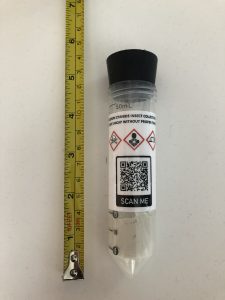If you have reached this page, you are either curious about the methods with which I am collecting bees for identification purposes, or you have found one of my collection tubes with a QR code.

Cyanide collection tubes have been used in entomology for decades. With proper construction, they should pose almost no threat to human health. Our tubes contain very small amounts (less than a teaspoon) of potassium cyanide salts wrapped in laboratory-grade tissue and covered in plaster of Paris. The tubes themselves are made of polypropylene plastic to prevent shattering and are capped with a rubber stopper. Thus, they should produce only enough cyanide gas to quickly kill any insects collected inside them. This is the most humane method used in the field, and also does a good job in preserving insect colour and DNA.
If you find a collection tube lying around, please contact me right away (250-740-1397 or sfan@zoology.ubc.ca) to arrange a safe return. DO NOT UNCAP A COLLECTION TUBE UNDER ANY CIRCUMSTANCES, and keep away from people and curious pets. If you find that it is cracked or damaged, please place into an airtight Ziploc bag or tupperware to be extra cautious.